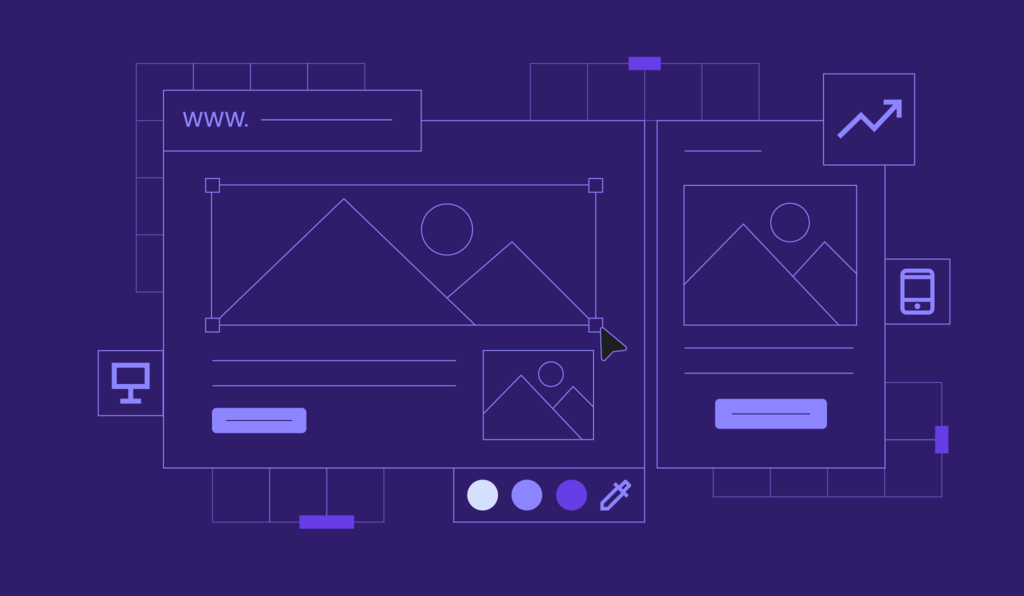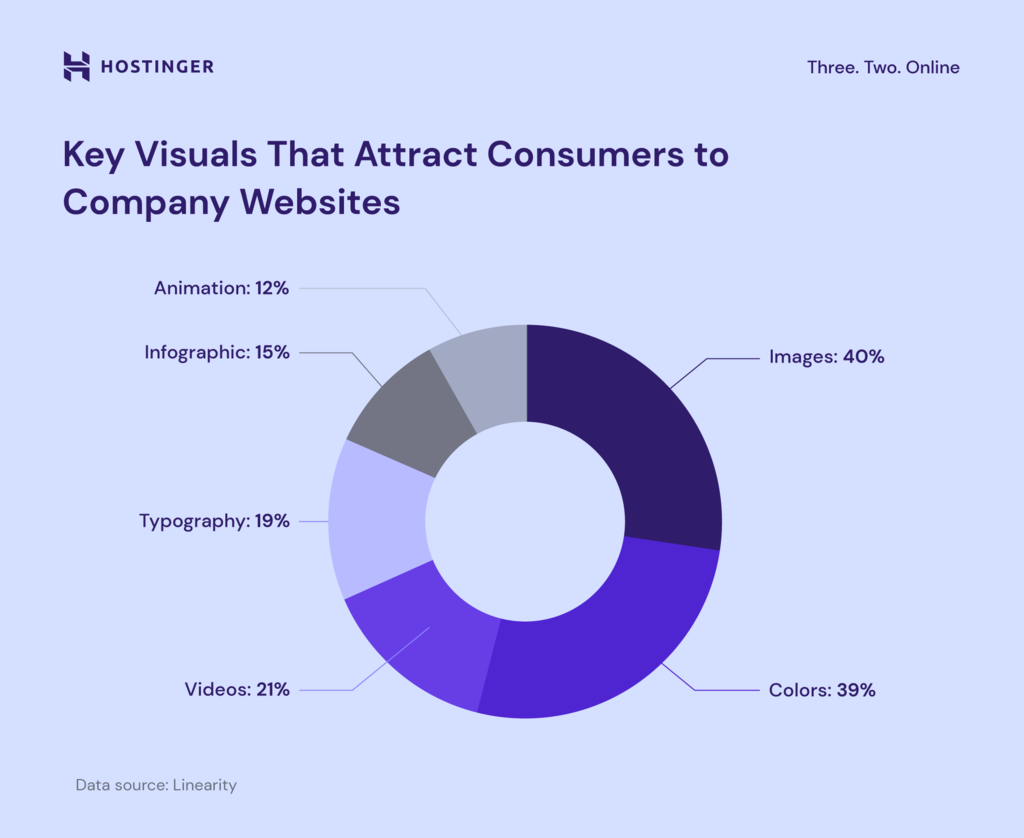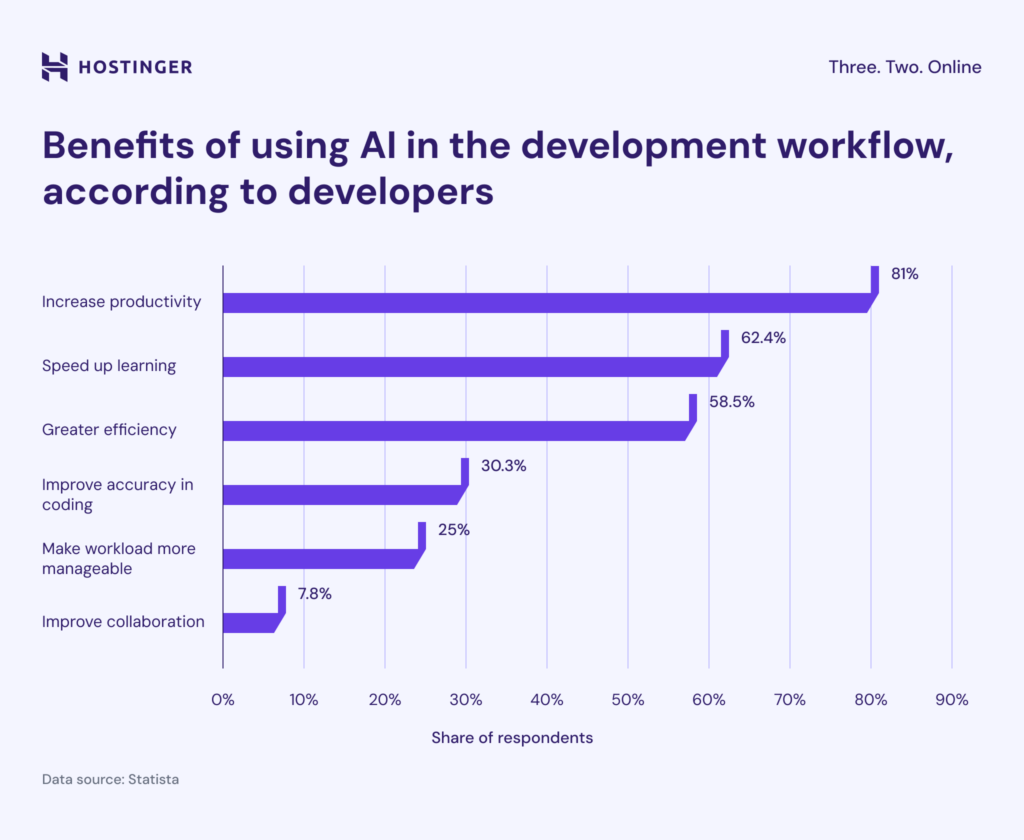28 essential web design statistics for 2025: Key trends and insights

A well-designed website sets the stage for a successful digital marketing strategy, and in 2025, design professionals and companies are adapting fast to AI-driven web design tools.
Understanding the latest trends and newest challenges in web design and consumers’ responses to these will enrich the decision-making process for digital entrepreneurs.
The following insights will prepare marketers, business owners, and content professionals to fully exploit web design’s aesthetic and functional aspects.
Top 10 web design statistics you should know in 2025
- Web design influences 94% of potential customers’ first impressions of a page.
- Over half of web designers use AI to generate imagery or media assets.
- Poor design and content drive 38% of web visitors away.
- Slow image loading causes 39% of users to lose interest and move on.
- Around 90% of websites today have implemented responsive design.
- Retailers lose $2.6 billion annually due to slow websites.
- Mobile optimization dominates among 62% of top-ranking websites.
- Great UX design can drive conversion rates by up to 400%.
- Ecommerce sites’ conversion rates average between 2.5%–3%.
- Nearly 93% of today’s web designers use AI tools.
General web design statistics
Design trends change year over year. Websites with fresh and innovative designs can fuel conversion rate growth and better brand awareness. The following statistics illustrate how effective images and text can appeal to customers and leave a lasting impression.&
1. Web design influences 94% of first impressions
Visitors take just 50 milliseconds to form an opinion about your site, making first impressions crucial for converting organic website traffic into leads. Moreover, 75% of visitors see well-designed websites as more trustworthy, directly influencing their decision to engage with your brand.
2. Great UX design can drive conversion rates by up to 400%
Deploying a seamless UX design may lead to 4 times more conversion actions, according to landing page statistics. In simple words, UX design focuses on removing obstacles that prevent users from achieving an ultimate goal, like making a purchase.
3. Poor design and content drive 38% of web visitors away
After passing the 50-millisecond review, retain visitor engagement with appealing website design and valuable content. A poorly designed website with irrelevant information can drive 38% of users away.
With 86% of users looking for product and service information, not finding what they came for can be a significant downside. Luckily, testing with at least five or more users can resolve 85% of user experience (UX) problems.
4. Consumers favor images over other visual elements on business websites
40% of visitors value images as an essential element on company websites. Fitting colors rank second by influencing 39% of users, followed closely by typography, infographics, videos, and animations. These numbers align with another finding that websites with images and videos see up to an 80% increase in user interaction.
Interestingly, the type of image matters. Original graphics tend to drive 20% more engagement than stock photos, highlighting the value of unique visual content on business websites. As visitors spend around 5.94 seconds reviewing a website’s main image, focus on making it attractive and original to keep them engaged.

5. Slow image loading causes 39% of users to lose interest
Given that visitors value images highly on websites, it’s no surprise that 39% of users lose interest when images load slowly.
Slow image loading can also hurt conversions. 67% of consumers stated that product images greatly influence their purchasing decisions. If these images take too long to load, potential customers may become impatient and leave the website.
6. Design is a priority for around 73% of companies seeking brand differentiation
Most companies (73%) rely on design to differentiate themselves from their competitors. Web design is one of the first and most essential tactics for building a clear and unique branding strategy.
7. Website design costs range from $500 to $10,000
Website design pricing varies widely, with most projects costing between $500 and $10,000 depending on features, complexity, and the designer’s experience. Factors such as content creation, ecommerce integration, and custom functionality can significantly influence the final bill.
Over half of businesses justify this investment because they want a completely unique website. Given that 87% of small business owners intend to create a website, the increasing popularity of website-building solutions like Hostinger Website Builder significantly lowers costs for individuals and small businesses.
8. Custom CTAs boost visitor conversion by 42%
While adding calls-to-action (CTAs) is a common marketing strategy, it’s crucial to put some thought into them. That’s because personalized CTAs convert 42% more users than generic ones.
Besides optimizing the action words, conduct A/B testing on your CTA buttons’ design. CTAs designed as buttons get 45% more clicks. However, various case studies have shown that red isn’t always the best color for conversions.
Find the ideal CTA design that resonates with your audience for improved results.
Web design industry statistics
Investment in web design reflects how crucial it is for companies in 2025. Designing a website with clear communication and performance goals is key to improving revenue and conversion rates.
9. The web design industry generated $43.5 billion in 2024
The US web design services industry reached $43.5 billion in revenue in 2024, reflecting the sector’s continued growth and the increasing demand for digital presence among businesses.
10. The global web design market size is expected to reach $92.06 billion by 2030
Projections indicate that the global web design market will expand to $92.06 billion by 2030, driven by rising internet usage, mobile adoption, and the need for businesses to compete with well-designed, user-friendly websites.
11. Retailers lose $2.6 billion annually due to slow websites
Websites that take over two seconds to load potentially lose 60% of their visitors. Even just a one-second delay can lead to 7% fewer conversions, which explains retailers’ massive overall revenue losses ($2.6 billion).

12. Ecommerce sites’ conversion rates average between 2.5%–3%
On average, ecommerce websites convert 2.5% to 3% of their visitors into customers, illustrating the importance of effective design and user experience in driving online sales.
13. About 27% of small businesses don’t have a website
Based on small business statistics, approximately 27% of small companies still operate without a website despite the advantages of having an online presence.&
14. The total number of website designers in the US is projected to exceed 229,000 by 2032
Employment projections show that the number of website designers and digital interface professionals in the United States will surpass 229,000 by 2032, highlighting ongoing demand for web design expertise.
Responsive web design statistics
This section discusses essential statistics about website responsiveness on various devices and relevant trends to help you plan your next website audit.
Keep in mind that responsive design is different from mobile-friendly design. Responsive design enhances user experience on all devices by ensuring that layout and content presentation can adapt to various screen sizes and proportions. On the other hand, mobile-friendly design prioritizes UX on mobile devices regardless of the degree of responsiveness.
15. Around 90% of websites have implemented responsive design
If your website isn’t responsive, you’re in the minority. In 2025, 90% of all websites, corresponding to 1.2 billion worldwide, have implemented responsive design.
As a key web design principle, most agencies and website-building solutions have embraced this approach. For example, Hostinger equips its website builder with responsive page templates for different niches, making sure your website looks great on all screen sizes.
16. Websites with responsive design achieve 11% higher conversion rates
One of the reasons most websites use responsive design is to boost conversions. More than half of businesses support this claim, reporting sales growth after adopting a responsive website design.
User engagement can also benefit from this web design principle. Mobile users engage 15% more with responsive platforms, leading to increased unique clicks and longer sessions for improved search engine optimization (SEO) rankings.
17. Slow task completion drives 79% of users away from websites
Great website design should be both user-friendly and visually appealing. Poor website usability, like frustrating navigation or cluttered layouts, drives 79% of visitors away.
Responsive design avoids this issue, ensuring consistent website performance across desktop and mobile devices. In fact, 88% of users with a positive browsing experience are more likely to return, highlighting the importance of responsive design for user retention.
18. Lack of responsive design is the top reason for website redesign
53.8% of website designers believe that not having a design that is responsive to all screen sizes is a primary reason for a website redesign. Other common reasons include low conversion rate (80.8%), high bounce rate (65.4%), and poor UX (61.5%) ‒ all of which can be improved with a responsive design.
Whether you’re looking to attract new visitors, retain your current audience, or increase conversions, implementing a responsive design should be a priority.
Mobile web design statistics
Like responsive design, mobile-friendly design adapts to the rapid growth of mobile users. This section will highlight must-know mobile web design statistics to improve conversions, SEO, and traffic, covering current trends and user behaviors.
19. Mobile optimization dominates among 62% of top-ranking websites
The latest ecommerce statistics forecast a 30.6% growth rate in smartphone usage, reaching 6.3 billion users in 2029. Website owners, especially those who rank, anticipated this trend by implementing mobile optimization.
Besides improving SEO efforts thanks to Google’s mobile-first indexing, mobile-friendly websites see 40% higher conversion rates. In contrast, 45% of users often have poor user experience with non-mobile optimized sites, resulting in a 60% bounce rate.
20. Mobile site abandonment peaks with slow loading times
Users’ dislike of slow loading times is a persistent trend, even on mobile sites. 88.5% of them consider it a top reason to go somewhere else, more than poorly designed navigation and cluttered content structure.
Interestingly, non-responsive design ranks second despite directly causing slow loading times. Websites not optimized for mobile usually load slower than those that are because they often have unoptimized elements. Large images and complex scripts, for example, take more time to download and render on mobile devices.
For this reason, remember to include mobile devices when testing website speed.

21. Over half of users will not endorse websites with poor mobile design
Poor mobile experience and brand reputation go hand in hand. If users can’t easily access your website on mobile, 57% are less likely to recommend it. As a result, you may lose organic traffic – or potential customers.
A mobile-friendly design can increase repeat website visits by a whopping 75%. It also helps build audience trust and loyalty, showcasing your commitment to providing a consistent user experience across all devices.
22. Over 84% of visitors prefer mobile websites over desktop
Most visitors believe that mobile sites should be just as good, if not better, than their desktop versions. With 77% of searches coming from mobile, businesses that neglect their mobile sites risk leaving a negative impression on 84% of users.
Additionally, mobile-friendly design boosts revenue by influencing the purchase decisions of 60% of consumers. As 78% of mobile-based searches often lead to offline purchases, it’s just as beneficial for local businesses as it is for ecommerce websites.
23. Irrelevant pop-ups annoy 70% of mobile website visitors
When using pop-ups, consider their impact on your website’s usability and accessibility.
Usability-wise, pop-ups that are difficult to close or appear frequently can disrupt user flow, frustrating 70% of mobile visitors. They also make it difficult for users with disabilities to access important information, contributing to the statistic that only 50% of mobile websites fully support this group.
The rise of AI in web design
In recent years, artificial intelligence (AI) has benefited nearly all industries, including web design. This section will take a closer look at how AI is changing how developers design and build websites.
24. Nearly 93% of web designers use AI tools
Almost 93% of web designers now incorporate AI tools into their workflows, leveraging automation and intelligent features to enhance creativity and streamline design processes.
Furthermore, 55% of designers claim that companies and clients support their decision to design websites with AI.
25. About 55% of designers say clients back AI in web design
Over half of web designers report that their clients support the use of AI in web design, signaling growing acceptance of artificial intelligence as a standard tool in the industry.
26. AI tools are boosting productivity for 81% of developers
A significant 81% of developers report increased productivity from integrating AI tools into their workflows, with AI assisting in tasks ranging from code generation to design optimization.

27. More than half of retail and ecommerce brands are now using AI for website creation
According to Hostinger’s AI in business statistics study, more than 50% of retail and ecommerce brands have adopted AI technologies for building and managing their websites, aiming to improve user experiences and operational efficiency.
28. Over half of web designers use AI to generate imagery or media assets
When it comes to benefits, 58% of web designers use AI for unique imagery and media assets. 51% of them create web page designs with the technology, contributing to increased productivity.
AI also plays a significant role in design planning. 49% of designers employ it to experiment with new design strategies or elements, while 43% use it to make design improvements. Similarly, 40% of web designers apply AI in design performance and quality tracking, and the other 20% for auditing user experience.
Sources
- IBISWorld
- SWEOR
- Abmatic AI
- Go-Globe
- W3Techs
- Sixth City Marketing
- Zippia
- BusinessDIT
- Forbes
- Similarweb
- WebFX
- Linearity
- HubSpot
- GoodFirms
- Fiverr
- Mordor Intelligence
- Invespcro
- Stackoverflow
- Statista
Conclusion
Every business should have a unique marketing message that can be amplified with thoughtful and professional web design. In 2025, designing a higher-quality website is easier and less expensive with the use of AI and other online tools.
Attractive, responsive, and mobile-friendly web design influences customer behavior. High-quality website design can increase users’ trust and brand awareness.
The role of AI tools has grown in this industry, with developers and designers embracing AI to complete projects more efficiently and achieve better quality results.
Web design statistics FAQ
Are companies investing in web design to differentiate their brand?
Yes, 73% of companies invest in web design to create unique, engaging brands. This trend highlights the growing need for businesses to have a strong online presence.
How much does web design cost?
The cost of designing a website varies depending on your goals and your desired approach. You can hire a designer for anywhere from $500 to $10,000 per project. With AI tools, you can take web design into your own hands, greatly lowering your costs.
How many hours does it take to build a website?
The time it takes to build a website varies depending on factors like tools, site size, and content type. You can easily create a simple portfolio or landing page in just a few hours using a website builder. Building a larger, feature-rich enterprise website can take several months.
Can AI design a website?
Multiple AI tools can assist in designing a website. For example, ChatGPT can help with basic tasks such as generating content ideas, code snippets, and visuals you can use. Additionally, some AI-powered website design solutions can even build a website from scratch, meaning you don’t need any coding knowledge to use them.
Is the web design industry growing?
Yes, the web design industry is growing rapidly. In the US, the market size reached $43.5 billion in 2024, with a 2.2% compound annual growth rate (CAGR). This growth reflects the increasing demand for professional web design services as businesses aim to improve their online presence.
Why is responsive design important?
Responsive design is crucial as it ensures website layouts can adapt to different devices, enhancing user experience. With mobiles driving over half of web traffic, a responsive site can significantly increase customer satisfaction, retention, and conversion.
How does good web design impact seo?
Effective web design impacts search engine optimization (SEO) by improving site navigation and speed for optimal user experience. It leads to longer user engagement and better search engine rankings, bringing you more traffic and conversions.
All of the tutorial content on this website is subject to Hostinger's rigorous editorial standards and values.




